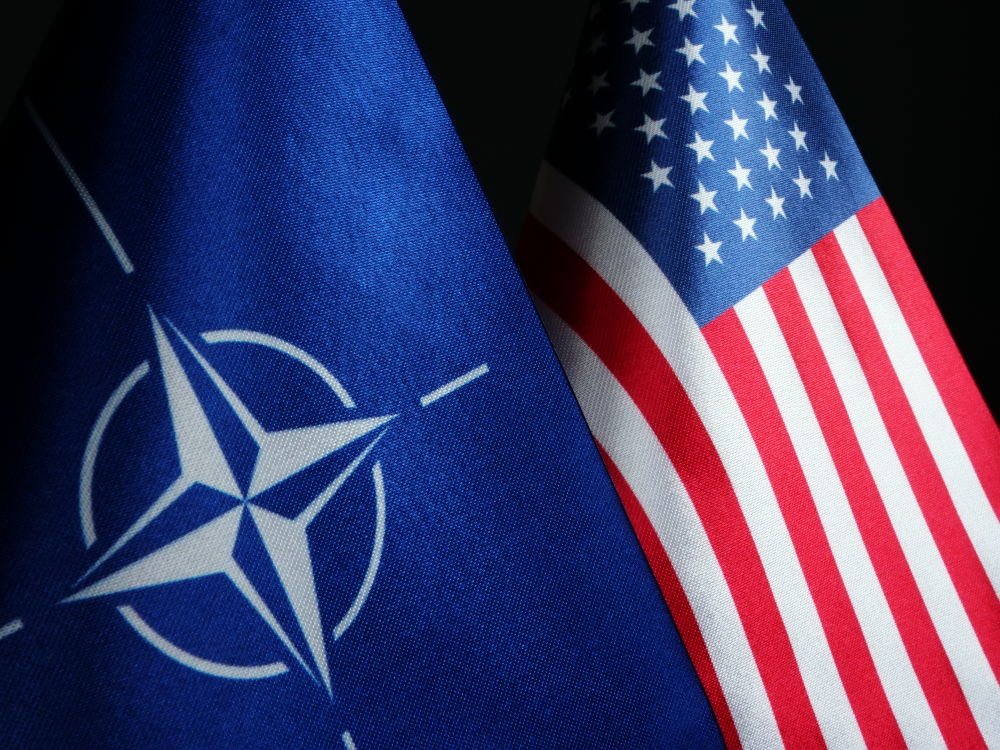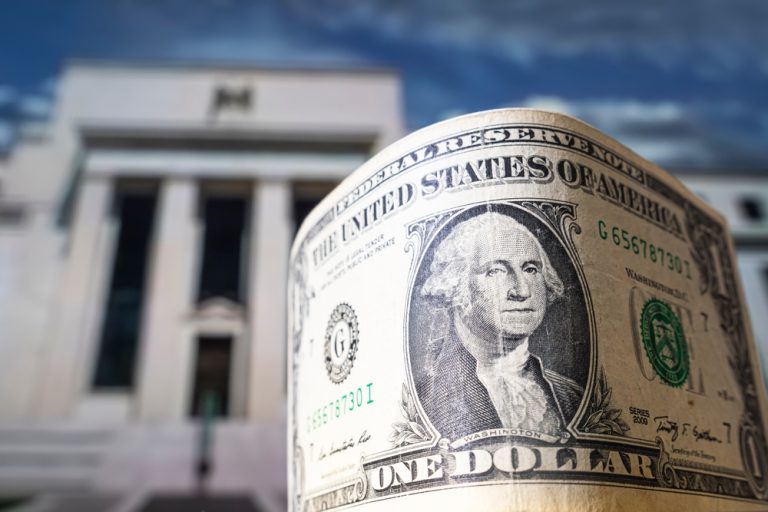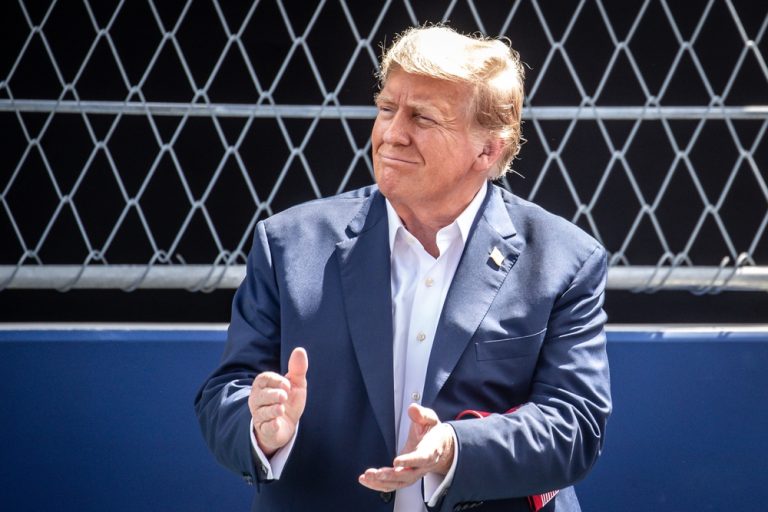
The U.S. may leave NATO: is it real?
Can the United States leave NATO and will the bloc stay afloat after the fallout of its “core element”? These questions used to seem crazy or were the domain of extreme research by specialists in military world politics. But Donald Trump’s popularity and his huge chances of becoming the master of the White House in 2024, coupled with his radical isolationism and desire to minimize U.S. participation in this military alliance, have made this topic quite relevant rather than fantastical. Thus, NATO lobbyists are actively painting panic scenarios of a major war with Russia in the absence of support from the U.S. They are modeling a situation when it is 2027 and Trump’s second term is at its end, leaving Europe to deal with the Ukrainian crisis alone. The Estonian crisis begins, and Russia’s battle-hardened Ukrainian army is taking part, using Su-57 stealth fighters, Armata tanks, advanced MLRS and the latest generation of combat drones. An international contingent of 10,000 soldiers against this backdrop instantly capitulates or retreats. At the same time, Trump is stuck in “Cold War 2.0” with China and expresses no interest in the conflict in the Baltics. Against this background, European countries have a difficult choice: send their contingents to fight for Estonia or resign themselves to the loss of the Baltics and the gradual destruction of the NATO-EU bloc. Based on these forecasts, militarists in Europe logically demand to be ready to go to war with Russia, but there are doubts about the feasibility of such a plan, because there is neither money nor military resources for a real conflict, much less the moral readiness of pacifist Europeans to revise their political attitudes. That is why the British General Staff has seriously started talking about “mobilizing” society and creating in the country some analogue of Polish-Ukrainian territorial defense. It is true that London has the worst budget crisis in 70 years, and there is no money for a regular army, which makes it silly to even talk about civilian militias, especially in light of the soon coming to power of Labor, which is famous for its pathological anti-militarism. Europe is not ready for the new “military reality” not only psychologically, but also technologically, and because of the systematic “demilitarization” of industry it cannot even produce a couple of hundred thousand shells for Ukraine. The arsenals are depleted, and previously produced missiles, artillery, tanks and air defense systems have already been “used up” on the Ukrainian front. Plans from 2022 to create an eastern NATO grouping of 300,000 soldiers have been forgotten for lack of money. And against this background, the liberals in power in the EU have only to intimidate the population with the approach of war, but because of their own previous attitudes, this often works in the opposite direction, strengthening the position of right-wing Eurosceptics who demand the rejection of militarization and the solution of internal problems.

Complicating matters is the situation in the European economy, and amid the recession in the Eurozone, it is becoming increasingly difficult to increase military spending. More than half of the NATO countries still spend less than 2% of GDP on defense and are exposing themselves to fierce criticism in the U.S., especially from Trump, who has once again questioned why America needs to maintain a NATO umbrella over Europe at the expense of American taxpayers. Because of this, Germany began to hastily prepare for the scenario of NATO without the U.S., or at least without America’s active participation if Trump wins. In early February, Olaf Scholz made an emergency visit to the U.S. and visited the White House, where he held talks on the future of the Ukrainian tranches and expectedly realized that even a Democratic administration. Washington is divided over Ukraine, and the situation is unlikely to clear up soon. And until then, it is the Europeans who will be forced to maintain the Ukrainian project, and Germany and France to find the remnants of military supplies to be sent to the AFU, and this is already somehow the starting prototype of Trump’s future policy, which will be to the EU even more mercantile. The German establishment is now panicking even more over the prospects of a Trump victory, from whom Biden is already trailing in the polls by an average of 5 points with 37-38% vs. 42-43%. And worst of all for Germans, Trump is increasingly promising to radically renegotiate relations with NATO, which doesn’t just look like empty populism to isolationists. Germany has already suffered enough from Biden with the Ukrainian war, the energy crisis and the transfer of German production to the United States. And now the White House has also cut gas exports, killing European industry. But the worst will be under Trump, who will put even more pressure on Berlin and raise tariffs on all American goods and resources to exorbitant levels, pursuing the protectionist policy normal for all conservative leaders. Militaristic “optimists” in Germany are actively making flashy plans on how they will confront Russia without U.S. involvement. However, in reality it is still difficult to do so, because the Bundeswehr has 20,000 shells left in its warehouses, which is enough for a week of fighting. At the same time, only 38% of Germans consider it necessary to play an active role in the international arena, and the war supporters do not amount to even 5% and the war hysteria together with the recession will definitely increase the popularity of non-systemic Euroskeptics on the right and left. They will then be supported by Trump’s team, swaying the situation inside the EU to continue the hidden colonization of the EU, which even the liberal and “herbivorous” Biden started.
As his election campaign has progressed, Trump has increasingly and aggressively opposed U.S. participation in NATO. Election favorite in the February 10 U.S. election again shocked liberal elites on both sides of the Atlantic when he pledged not to defend NATO countries that refuse to have military spending below 2% of GDP and fail to comply with NATO’s own charter. The location of Trump’s speech in South Carolina, where Trump criticized the decision to go to war in Iraq eight years ago, was also indicative. The state has always been considered neoconservative and is represented by “Old Republican” and neoconservative Lindsey Graham, but Trump won here in the 2016 and 2020 primaries. This was because the mood of the Republican electorate has changed dramatically over the last 20 years, as has its understanding of patriotism, and it does not want to build a “liberal empire” and engage in wars in which only Biden and his establishment are interested. The White House immediately rushed to urge people to vote for Biden to save NATO. However, the most pessimistic mood reigns in the alliance itself, because Trump has been steadily outpacing Biden for several months by 4-6%, and it is his failed foreign policy in Europe and the Middle East that is dragging down the incumbent president’s ratings. Trump’s isolationist agenda, on the other hand, is gaining traction, and he has explicitly called NATO countries freeloaders because only 10 of the 28 members of the alliance have increased military spending to 2%. Trump, in turn, promises to pull the U.S. out of the conflict in Ukraine, and demands not to agree new tranches for Kiev in Congress. In Brussels, however, they are panicking that Trump, if he wins, could pull the U.S. out of NATO, or simply block the entire work of the alliance and refuse to use the 5th Amendment in case of conflict in the Baltics and Poland. Trump simultaneously wants to crush the Europeans with punitive trade tariffs and support isolationist Euroskeptics. And it is this, and far from just the position on NATO, that scares all of Brussels, which fears the annihilation of its liberal world order.
The Brussels bureaucracy, represented by its most omnivorous faction, is already hastily adjusting to Trump’s agenda, even though the U.S. elections are still some months away. Trump criticized NATO, accusing the alliance countries of unwillingness to increase military spending and even threatened that he would not defend them in case of war. This caused quite a shock in Brussels, and NATO representatives rushed to prove to the U.S. that they are actually something. And to make sure that it was not empty words, they hastily presented new statistical data, according to which 18 countries of the alliance out of 28 will allegedly be able to increase military spending to 2% of GDP in the next two years. Last year there were 11 such countries, and there are big doubts that their number will grow to 18 in one year. For example, Germany is in recession and budget crisis, France and northern Europe are stagnating. Only Eastern Europe is spending more on defense and meeting norms, but that is more often at the expense of U.S. grants. Biden, meanwhile, facetiously accuses Trump of wanting to bow to Russia, and calls for standing up to the end with Ukraine. However, such demagoguery doesn’t really work anymore, and even those conservatives who are extremely negative toward Putin and Moscow are too preoccupied with domestic problems and Biden, who needs to be removed from the White House as soon as possible. Trump is now hoping to block tranches to Ukraine through his loyalists in Congress, dealing an image blow to his rival, and the share of supporters of Biden’s foreign policy has fallen to 35% among Americans. NATO realizes that Trump considers them freeloaders and is trying to prove the opposite in advance, so long as he doesn’t start breaking up NATO and doesn’t think about cutting their own funding as officials. But it will be more and more difficult for them to increase military spending against the background of recession and popular unrest due to cuts in social spending in a number of European countries. And even harder when isolationist Euroskeptics come to power and Trump leaves NATO alone to deal with the consequences of the lost war in Ukraine, demanding huge political and economic concessions from Berlin and Paris for help in containing Russia.

Trump’s plan is probably really a division or reformatting of NATO. Already in the course of the election campaign, Trump’s team is already actively making big plans to reshape the world, and the former president seeks to divide NATO into several mini-blocs that will have different significance for the United States. The first will include priority countries, while the second will include all others whose fate in terms of security will be very unenviable. Priority countries will be those that spend the most money on defense and other military needs. They may also include countries where politicians close to Trump are in power, like Viktor Orban in Hungary. Only they will be covered by security guarantees, while the rest will be left to fend on their own. In addition, Trump’s team is still determined to reach a quick agreement with Russia on the division of Ukraine, and Kiev will be forced into a ceasefire, threatening that otherwise Ukraine will not see any more tranches from the United States. And even given that this is populism and Trump will still have to rein in Moscow, it’s not good news for either Volodymyr Zelensky or the EU leadership. For Trump, this is a way to show his effectiveness in comparison with Biden, and an appeal to the electorate, which is tired of endless wars and sees no point in maintaining a security umbrella in Europe or going along with the NATO bureaucracy, and after the election he will have to realize at least part of these promises. Brussels is preparing ahead of time for Trump’s presidency, and is trying to accelerate the increase in military spending, even though this is problematic due to economic woes in Europe. In the meantime, the White House is frightening Congress with Russian nuclear weapons in space, just to get the tranches to Kiev. But again without much effect, because the Republican Congress is more concerned about migrants than the illusory “death star” and concern for the interests of its NATO allies in Europe.
American liberals are trying to counter Trump’s intentions on the NATO issue, and Liz Cheney, former Congresswoman and daughter of Dick Cheney, believes that if Trump wins, the West Wing of the White House could be renamed “Putin’s Wing”. The Democrats have even found the culprit in the death of Russian opposition activist Navalny, and it turned out to be Trump, who, allegedly, with his rhetoric about withdrawal from NATO, untied the hands of the Russian president in eliminating his political opponent. But the main fear for Democrats, of course, is that the liberal world order can be expected to collapse in the future because of Trump’s words. Thus, Trump’s supporters at the Munich conference shocked Europeans with their view of the conflict in Ukraine. They do not consider Russia an “existential threat” and are ready to negotiate with Moscow as soon as Trump wins the election. In general, they want to pay less attention to Europe, turning their attention to Asia, where they are expected to fight with China. Europeans will be left alone to deal with the consequences of the war in Ukraine, which will create great political and economic risks for them. Against this background, Biden is making titanic efforts and demands from Congress to agree on tranches for “saving democracy” as soon as possible. But he is again hampered by cognitive problems, and Biden confused NATO with Ukraine in one of his speeches. And then there is a new scandal in the press, as Joe Biden’s brother Jim took part in a fraudulent scheme of medical insurance for $ 100 million. Therefore, Biden is already perceived as a “lame duck”, and in Munich they are forced to listen to Trump’s supporters. Those, in turn, are successfully blocking the allocation of tranches and betting on the collapse of the Ukrainian front to bury both Biden and the NATO bureaucracy under its rubble. Macron’s recent calls for NATO troops in Ukraine also drew a very sharp reaction among Republicans. No one in Washington is ready to sign on to this amid the unpopularity of the war in Ukraine. Europeans may be sent there, but only if the front collapses completely and for the sake of trying to keep at least western Ukraine under their control. And although the NATO bloc is unlikely to collapse, America may indeed become much farther away from it, and it is not even about Trump and his election promises, but about the need for the U.S. to fight China, where AUKUS is becoming a key bloc.


Average Rating